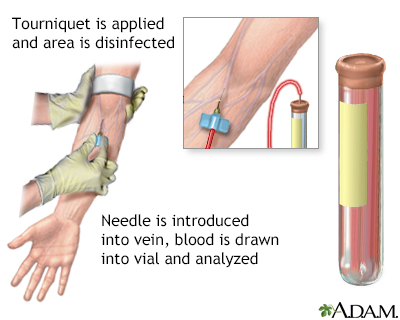HLA-B27 antigen
Human leukocyte antigen B27; Ankylosing spondylitis-HLA; Psoriatic arthritis-HLA; Reactive arthritis-HLA
HLA-B27 is a blood test to look for a protein that is found on the surface of white blood cells. The protein is called human leukocyte antigen B27 (HLA-B27).
Human leukocyte antigens (HLAs) are proteins that help the body's immune system tell the difference between its own cells and foreign, harmful substances. They are made from instructions by inherited genes.

Blood is drawn from a vein (venipuncture), usually from the inside of the elbow or the back of the hand. A needle is inserted into the vein, and the blood is collected in an air-tight vial or a syringe. Preparation may vary depending on the specific test.
How the Test is Performed
A blood sample is needed. Most of the time, blood is drawn from a vein located on the inside of the elbow or the back of the hand.
How to Prepare for the Test
No special steps are needed to prepare for the test.
How the Test will Feel
When the needle is inserted to draw blood, you may feel moderate pain, or only a prick or stinging sensation. Afterward, there may be some throbbing.
Why the Test is Performed
Your health care provider may order this test to help determine the cause of joint pain, stiffness, or swelling. The test may be done along with other tests, including:
- Anti-cyclic citrullinated peptide (CCP) antibody
- C-reactive protein
- Erythrocyte sedimentation rate (ESR)
- Rheumatoid factor
- X-rays
HLA testing is also used to match donated tissue with a person's tissue who is getting an organ transplant. For example, it may be done when a person needs a kidney transplant or bone marrow transplant.
Normal Results
A normal (negative) result means HLA-B27 is absent.
What Abnormal Results Mean
A positive test means HLA-B27 is present. It suggests a greater-than-average risk for developing or having certain autoimmune disorders. An autoimmune disorder is a condition that occurs when the immune system mistakenly attacks and destroys healthy body tissue.
A positive result can help your provider make a diagnosis of a form of arthritis called spondyloarthritis. This kind of arthritis includes the following disorders:
- Ankylosing spondylitis
- Arthritis related to Crohn disease or ulcerative colitis
- Psoriatic arthritis (arthritis associated with psoriasis)
- Reactive arthritis
- Sacroiliitis (inflammation of the sacroiliac joint)
- Uveitis
If you have symptoms or signs of spondyloarthritis, a positive HLA-B27 test may help confirm the diagnosis. However, HLA-B27 is found in some healthy people and does not always mean you have a disease.
Risks
Risks from having blood drawn are slight, but may include:
- Excessive bleeding
- Fainting or feeling lightheaded
- Hematoma (blood accumulating under the skin)
- Infection (a slight risk any time the skin is broken)
References
Kumanovics A, Lazar-Molnar E, Delgado JC. The major histocompatibility complex and disease. In: McPherson RA, Pincus MR, eds. Henry's Clinical Diagnosis and Management by Laboratory Methods. 24th ed. Philadelphia, PA: Elsevier; 2022:chap 51.
Inman RD, Rahman P. Spondyloarthritis. In: Goldman L, Cooney KA, eds. Goldman-Cecil Medicine. 27th ed. Philadelphia, PA: Elsevier; 2024:chap 244.
Inman RD, Fitzgerald G. Classification and epidemiology of spondyloarthritis. In: Firestein GS, McInnes IB, Koretzky GA, Mikuls TR, Neogi T, O'Dell JR, eds. Firestein & Kelley's Textbook of Rheumatology. 12th ed. Philadelphia, PA: Elsevier; 2025:chap 75.
Version Info
Last reviewed on: 4/1/2025
Reviewed by: Diane M. Horowitz, MD, Rheumatology and Internal Medicine, Northwell Health, Great Neck, NY. Review provided by VeriMed Healthcare Network. Also reviewed by David C. Dugdale, MD, Medical Director, Brenda Conaway, Editorial Director, and the A.D.A.M. Editorial team.
